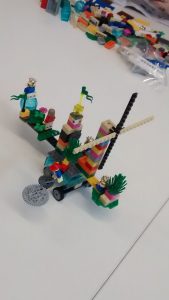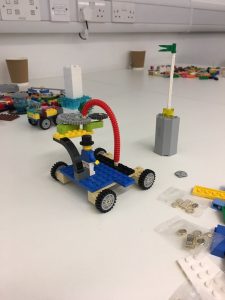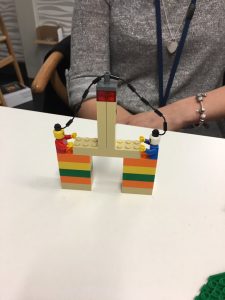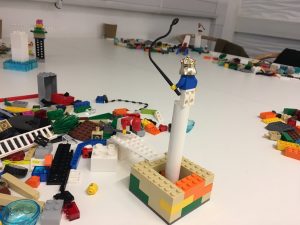Author: Luca Morini 25th April 2017
On the 27th of March the GameChangers team hosted in the Disruptive Media Learning Lab the full team from the Centre for Global Engagement who, as a consequence of a phase of organisational transition in their area, asked us to support them in generating a Mission Statement and a discussion of Values through accessible and cooperative means, a need we decided to address through the LEGO Serious Play methodology (LSP).
This particular choice was due to a number of factors: the in-depth, abstract nature of the issues to be addressed, the necessity to generate a strongly shared direction and understanding and, last but not least, the intention to establish an ongoing collaboration toward embedding playful and gameful approaches in CGE-led courses and Summer Schools, approaches of which this same session would have provided a first showcase.
As the LSP methodology is founded in “thinking with the hands”, sharing and storytelling, it can often take a while for participants to get acquainted with this new mode of expressing themselves, so different from what happens during traditional meetings. This is where one of our opening exercises, “Build your Nightmare Colleague” exercise, which might seem to run contrary to a team building exercise, helps everyone understand what is best about the LSP methodology: to be able to build and to freely express and share even usually emotionally charged, organisationally jarring issues.
After the introductory exercises (which included the aforementioned “Nightmare Colleague” one, and a more general motivation based one), which are intended to help participants reach the necessary confidence in the methodology and in their own building/storytelling abilities, we moved through the core steps of the workshop: to build an individual expression of the Mission of the Centre, to move toward a shared modelling/understanding, and to make explicit and discuss the values that can support the achievement of this mission.
Having split the Centre in three groups, to more easily manage the plurality of narrative and give space to everyone involved, the different groups emphasised different aspects of the activity and of the mission of the centre, but touched on similar general themes: teamwork, leadership, excellence, clear processes and the richness of diversity provided by both staff and students. As an ideal synthesis of these themes, the clearest, most explicit and focused formalisation of the Mission Statement was probably the one shown below, materially represented in the model as a dynamic vehicle:

Developing students into global graduates through intercultural engagement (and a collaborative environment)
Going beyond this formal mission statement, by looking at the variety of models of Motivations, Nightmare Colleagues, Values and the shared narratives that accompany them, we can also highlight the emergence of three overarching, widely represented transversal themes, specific in their declinations and shape to the Centre but also quite pervasive and contested throughout Higher Education institutions, which are themselves experiencing strong tensions and transitions.

The first one is a strong ambivalence toward measurable objectives, such as KPIs (often represented in the models by flags of achievement), which, while understood as an unavoidable necessity for the accountability and management of such a complex and networked institution as the CGE (or a University as a whole), often are represented as operating toward trivialising and draining of meaning even the complex and multifaceted endeavour of bridging different cultures.

The second theme is that of Communication (often represented in models by flexible links and connecting gears), again perceived as ambivalent: on one hand, good communication and coordination is perceived as an absolute necessity of the Centre, one of its core values. On the other hand, there are also strongly delineated sub-teams which can sometimes be understandably defensive of their specific expertise and organisational autonomy.

The last, and more critical one (and, as to be expected, one that can be hard to discuss through traditional means in the presence of management) is that of hierarchy (usually represented in the models by crowns and towers). While indeed LSP enabled a more open discussion of this issue (as evidenced particularly by some “Nightmare Colleague” models), the pressure for political correctness and compliance can’t be completely avoided even in such a playful setting.
One group indeed slightly overcompensated by explicitly adopting a “no towers” policy and building a completely flat model where emphasis was on the equal importance of the staff as foundation of the centre. While this might be a desirable situation, the “policy” also curtailed avenues for individuals to express their concerns.
All in all, the session was most assuredly interesting and engaging for all the participants, which enjoyed a very different, playful approach to sharing and discussing their Mission and Values, coming out of it with a more explicit and clear field of discussion and new areas explored, if not with a definite understanding (the key question through which LSP facilitators support participants in building model is indeed “Can you live with it?”, entailing not uniformity or compliance, but shared viability)
Moreover, from a research and facilitation perspective, the session also illuminated of both the strong points (strong engagement and complete participation, with the potential to touch even usually “taboo” themes) and the limitations (hard to bring together such a large number of points of view, and the fact that power dynamics and playfulness never mesh too well together) of the methodology.
With a follow up meeting coming soon, we do hope this was only the first step of an ongoing, playful collaboration between DMLL and CGE.
